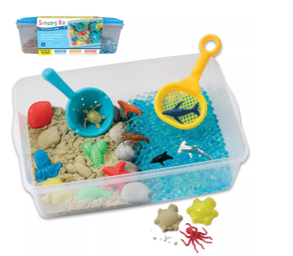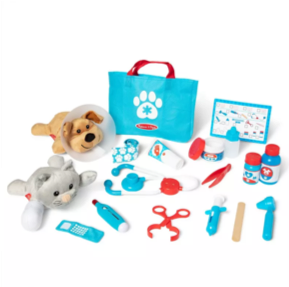These days, every month seems to represent something different to celebrate and May celebrates better speech and hearing!
Our goal is to highlight the many different areas and specialties speech language pathologists play across the lifespan for our patients. Unless you have a personal experience with speech therapy or a speech pathologist, you may not be aware of all the “hats” we can wear.
Let’s focus on pediatrics, speech pathologists treat a variety of speech and language disorders including apraxia, articulation disorders, phonological disorders, voice disorders, traumatic brain injuries, intellectual disabilities, social communication disorders, late language emergence, auditory processing disorders, fluency disorders and written language disorders. We also treat feeding and swallowing disorders including dysphagia, picky/problem eating and orofacial myology disorders.
…Just to name a few!
Let’s dive into a few that are common for our therapists to treat at Gro.
 Childhood Apraxia of Speech- or CAS is a neurological pediatric speech sound disorder where the precision and consistency of movements underlying speech are impaired in the absence of neuromuscular deficits (i.e. abnormal reflexes or tone). CAS may occur as a result of a known neurological impairment (i.e. brain damage) or independently. Think of it this way: the child knows what they want to say but has trouble coordinating the precise movements of the articulators to get the message out.
Childhood Apraxia of Speech- or CAS is a neurological pediatric speech sound disorder where the precision and consistency of movements underlying speech are impaired in the absence of neuromuscular deficits (i.e. abnormal reflexes or tone). CAS may occur as a result of a known neurological impairment (i.e. brain damage) or independently. Think of it this way: the child knows what they want to say but has trouble coordinating the precise movements of the articulators to get the message out.
Articulation Disorders- these fall under the umbrella term “speech sound disorders” and focuses on speech errors in production of individual speech sounds such as distortions or substitutions of a sound.
Phonological Disorders- these fall under the umbrella term “speech sound disorders” as well but these are predictable, rule-based errors that affect more than one sound such as fronting (saying “tat” instead of cat), stopping (saying “dun” for sun) or final consonant deletion (saying “go” for goat).
Augmentative and Alternative Communication- or AAC is an area of clinical practice that supplements or compensates for impairments in speech-language production and/or comprehension including spoken and written modes of communication. AAC is an umbrella term that can use any equipment, tool or strategy to improve functional communication for people. Some forms of AAC include signs, gestures, line drawings, written words, picture communication boards and speech-generating devices.

Voice Disorders- occurs when voice quality, pitch and loudness differ or are inappropriate for an individual’s age, gender, cultural background or geographic location. Voice disorders are categorized under 2 main categories including Organic and Functional. Organic voice disorders include structural and neurogenic and are defined as a physiological voice disorder that is a result from alterations in respiratory, laryngeal or vocal tract mechanisms. Structural organic voice disorders are a result from physical changes in the vocal mechanism such as alterations in vocal fold tissues (i.e. edemas or vocal nodules) and/or structural changes in the larynx due to aging. Neurogenic organic voice disorders are a result from problems with the central or peripheral nervous system innervation to the larynx that affect functioning of the vocal mechanism such as vocal tremors, spasmodic dysphonia or vocal fold paralysis. Functional voice disorders are a result from inefficient use of the vocal mechanism when the physical structure is normal, such as vocal fatigue, muscle tension dysphonia or aphonia, diplophonia or ventricular phonation.
Traumatic Brain Injuries- or TBIs are a form of nondegenerative acquired brain injury resulting from a bump, blow or jolt to the head/body or a penetrating head injury that disrupts normal brain function. TBIs can cause mild, moderate or severe brain damage that can result in speech, language, swallowing or auditory processing disorders.
 Intellectual Disabilities- or ID is characterized by the onset in the developmental period (before age of 22 years), significant limitations in adaptive behavior and significant limitations in intellectual functioning. The diagnosis of an ID is not made by a speech pathologist but children with IDs may benefit from speech, language and/or auditory processing therapy to help improve functional communication in the child’s daily life.
Intellectual Disabilities- or ID is characterized by the onset in the developmental period (before age of 22 years), significant limitations in adaptive behavior and significant limitations in intellectual functioning. The diagnosis of an ID is not made by a speech pathologist but children with IDs may benefit from speech, language and/or auditory processing therapy to help improve functional communication in the child’s daily life.
Late Language Emergence- this is often referred to as a “late talker” and is characterized by a delay in language onset with no other diagnosed disability or developmental delay in other cognitive or motor domains. Late language emergence is diagnosed when language development trajectories are below age expectations. Children may have expressive language delays only or they may have mixed expressive and receptive delays. Children with expressive language delays often exhibit reduced vocabulary and delayed sentence structure and articulation. Children with mixed expressive and receptive language delays will show a delay in oral language production and language comprehension.
Fluency Disorders- the most common fluency disorder is “stuttering,” which is an interruption in the flow of speaking characterized by specific types of disfluencies including the repetitions of sounds, syllables and monosyllabic words (i.e. “Look at the b-b-baby” or “Let’s go out-out-out”). Disfluencies can affect the rate and rhythm of speech and may be accompanied by negative reactions to speaking, avoidance behaviors, escape behaviors and physical tension.

Pediatric Feeding and Swallowing Disorders- This is an umbrella term so let’s break it down a little:
- Feeding- is the process involving any aspect of eating or drinking including gathering and preparing food and liquid for intake, sucking or chewing and swallowing. A pediatric feeding disorder is defined as “impaired oral intake that is not age-appropriate and is associated with medical, nutritional, feeding skill, and/or psychosocial dysfunction.” It may be associated with oral motor and oral sensory function and includes behaviors such as refusing age-appropriate or developmentally appropriate foods or liquids, accepting a restricted variety or quantity of foods or liquids, displaying disruptive or inappropriate mealtime behaviors, failing to master self-feeding skills expected for developmental levels, failing to use developmentally appropriate feeding devices or utensils and experiencing less than optimal growth.
- Swallowing- is the complex process during which saliva, liquids and foods are transported from the mouth into the stomach while protecting the airway. It consists of 4 phases: oral preparatory phase, oral transit, pharyngeal and esophageal. A swallowing disorder is called “dysphagia” and can occur in one or more of the 4 phases of swallowing and can result in aspiration (the passage of liquid, food or saliva into the trachea).
Long term consequences of feeding and swallowing disorders can include food aversion, oral aversion, aspiration pneumonia and/or compromised pulmonary status, undernutrition or malnutrition, dehydration, GI complications (i.e. motility disorders, constipation and diarrhea), poor weight gain, ongoing need for gastrointestinal or parenteral nutrition and prolonged feeding and swallowing problems into adulthood.
Orofacial Myology Disorders- or OMDs are patterns involving the oral and orofacial musculature that interfere with normal growth development, or function of orofacial structures, or call attention to themselves. OMDs can be found in children, adolescents and adults and can co-occur with a variety of speech and swallowing disorders. See our OFM blog post for an in-depth dive into this one 😉
That was A LOT!
Keep in mind that these are only a handful of disorders and diagnoses that speech pathologists can treat. Most SLPs have a passion for a few different areas but as you can imagine we can’t be experts in all of the areas so it’s important to find the right provider for you or your child’s needs!
(Reference: American Speech Hearing Association Patient Portal- Clinical Topics https://www.asha.org/practice-portal/clinical-topics/)










 Childhood Apraxia of Speech- or CAS is a neurological pediatric speech sound disorder where the precision and consistency of movements underlying speech are impaired in the absence of neuromuscular deficits (i.e. abnormal reflexes or tone). CAS may occur as a result of a known neurological impairment (i.e. brain damage) or independently. Think of it this way: the child knows what they want to say but has trouble coordinating the precise movements of the articulators to get the message out.
Childhood Apraxia of Speech- or CAS is a neurological pediatric speech sound disorder where the precision and consistency of movements underlying speech are impaired in the absence of neuromuscular deficits (i.e. abnormal reflexes or tone). CAS may occur as a result of a known neurological impairment (i.e. brain damage) or independently. Think of it this way: the child knows what they want to say but has trouble coordinating the precise movements of the articulators to get the message out.
 Intellectual Disabilities- or ID is characterized by the onset in the developmental period (before age of 22 years), significant limitations in adaptive behavior and significant limitations in intellectual functioning. The diagnosis of an ID is not made by a speech pathologist but children with IDs may benefit from speech, language and/or auditory processing therapy to help improve functional communication in the child’s daily life.
Intellectual Disabilities- or ID is characterized by the onset in the developmental period (before age of 22 years), significant limitations in adaptive behavior and significant limitations in intellectual functioning. The diagnosis of an ID is not made by a speech pathologist but children with IDs may benefit from speech, language and/or auditory processing therapy to help improve functional communication in the child’s daily life.
